Plumeria Tree: Flower, Fertilizer, Cutting Propagation and Care Guide

Plumeria is a group of small deciduous trees or shrubs and is famous for highly scented, exotic, showy flowers. Associated with the Pacific islands such as Hawaii, plumeria flowers are shaped like a star and come in shades of white, yellow, pink, red, and multi-colors. Plumeria trees are also known for their large, leathery leaves that decorate the attractive ornamental tree from spring until fall.
Plumeria trees are also called frangipani. The tropical trees are a member of the dogbane family Apocynaceae. Plumeria plants are classed as deciduous or semi-evergreen trees or shrubs. The spectacular flowering trees thrive in USDA zones 9 through 12. Plumeria trees commonly grow in Florida, the Caribbean, the Pacific islands, Mexico, and Central America.
Frangipani trees are moderate to fast-growing plants that can grow up to 20 ft. (6 m) tall. However, in most tropical and subtropical garden landscapes, the exotic trees reach between 6 and 8 ft. (1.8 – 2.4 m) tall. The only care plumeria trees require is plenty of sunlight, well-drained soil, water, and fertilizer.
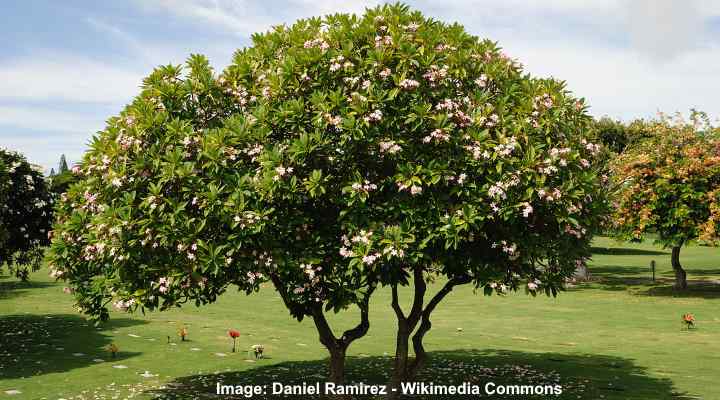
Plumeria tree
Because a plumeria tree loses its leaves in winter, the shrub-like tree can resemble a collection of branches growing from the ground. However, in spring, the plant’s beautiful foliage and spectacular plumeria flowers return to add an exotic touch to tropical gardens.
This article is a care guide to growing a plumeria tree in your garden. Pictures and descriptions of popular plumeria varieties will help you decide on the best frangipani to plant.
How to Grow Plumeria Plants
To care for a plumeria tree, grow the plant in full sun and well-draining soil. In pots or the ground, a frangipani tree thrives in any soil type. Water when the soil is dry and never water it in winter. Fertilize throughout the growing season and prune in spring.
Plumeria Flower
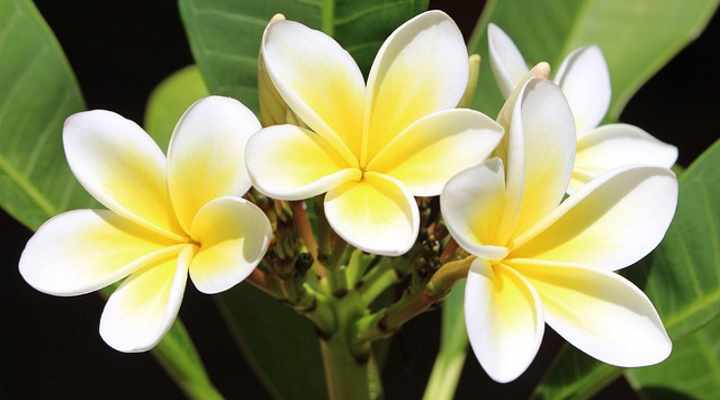
Plumeria scented flowers have 5 petals
Plumeria flowers are the most attractive part of this tropical deciduous tree. Plumeria trees have showy star-shaped flowers that consist of five petals and give off a sweet or spicy scent. The beautiful waxy tubular flowers grow in clusters on the ends of branch stems. There can be as many as 200 flowers on a single Plumeria plant.
Some say that tropical plumeria flowers smell like sweet peaches, citrus fruits, or jasmine. Some of the strongest smelling plumeria varieties emit scents like coconut, sweet roses, honeysuckle, ginger, or lemon. However, the particular smell of plumeria flowers is individual to each species or cultivar.
An unusual feature of plumeria flowers is that they emit a more pungent scent at night. This is thought to attract species of sphinx moths to pollinate the plant. However, plumeria flowers don’t produce any nectar. Instead, pollinated flowers produce two-horned seed pods that dangle in from branches.
You can expect frangipani trees and shrubs growing in the ground or containers to bloom for six months.
The most common way to use plumeria flowers is to create a Hawaiian lei—a floral garland common on pacific islands. The plumeria pink, white, or yellow flowers are strung together and placed around the necks of visitors, dignitaries, graduates, friends, or loved ones.
Plumeria Colors

Plumeria flowers are white, yellow, pink or multi colored
The colors of plumeria flowers are characteristic of a tropical paradise. The sweet-smelling or spicy aromatic frangipani flowers can be white, yellow, deep pink, or multi-colors. For example, the most exotic plumeria color combinations are white petals with bright yellow centers. Or deep pink or magenta with hues of orangey-yellow.
Plumeria Leaves
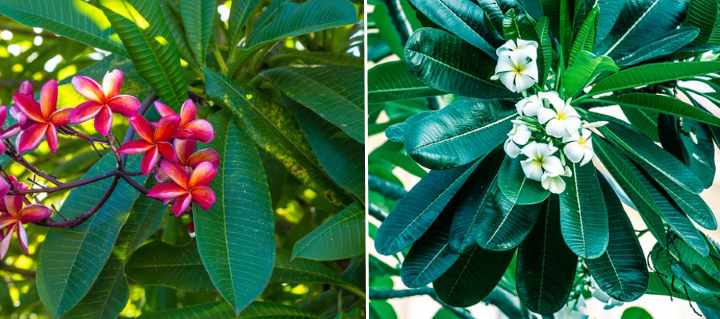
Plumeria leaf shape depends on the species
The large plumeria leaves can be ovate or spatula-shaped blades with pointed or rounded tips. Typically, plumeria leaves have pronounced, raised veining on leaves running from the midrib to the margins. Leaves measure 12” to 18” (30 – 45 cm) long and 8” to 12” (24 – 30 cm) wide.
The shape of plumeria leaves depends on the species of plant. In winter, most species of plumeria trees, such as the Plumeria rubra, drop their leaves. However, there are a few evergreen plumeria tree species like the Plumeria obtusa and Plumeria pudica.
Plumeria Seed Pods
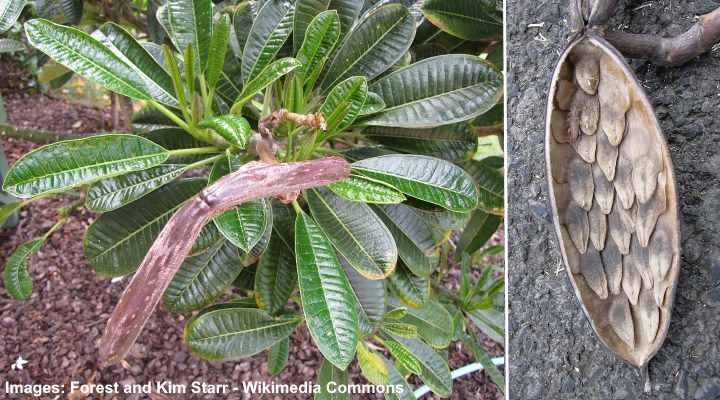
Plumeria seed pods
A pollinated plumeria flower develops into a two-horned seed pod. These bean-like pods dangle like an upside-down “V” shape. The brown pods have a pointed end, somewhat like a banana, and measure 8” (24 cm) long. The stiff, leathery pods contain between 20 and 60 winged seeds.
Plumeria Fertilizer
Plumeria trees benefit from fertilization when planted in the ground or pots. However, the best type of fertilizer for plumeria trees is one for flowering shrubs. For best plumeria blooming, apply a high-phosphorus shrub fertilizer in spring, summer and fall to encourage excellent growth and plenty of flowers.
When choosing a plumeria fertilizer, look for a high “P” number on the NPK. Some types of recommended “bloom boosting” plumeria fertilizers are ones with NPK ratios like 10-30-10, or “Hawaiian Bud and Bloom” 5-50-17, or “Bloom plus” 10-54-10.
Apply fertilizer every two to three weeks in the growing season. In the middle of the fall, reduce watering and stop applying fertilizer. You can resume watering and fertilization in spring when new growth appears.
Top tip for fertilizing plumeria plants: Don’t use too much nitrogen; otherwise, you’ll encourage too much foliage growth, and the plant will become leggy.
Plumeria Cutting Propagation
The easiest way to grow a plumeria tree is by taking stem cuttings in spring or summer. First, use a sharp knife to cut a 12” to 18” (30 – 45 cm) length of a healthy branch. Ensure that the cut is clean, without any ragged edges.
Next, leave the cut plumeria branch to dry for a week in a shaded, well-ventilated place so that the end forms a callus. Or you can wrap the plumeria cutting in damp coconut coir for two weeks.
After the callus has formed, fill a large pot with a potting mix of one-part potting soil and two-part perlite. Dip the cut end of the plumeria cutting in rooting hormone and plant the cutting 6” (15 cm) in the soil. Water the soil and then let the potting mix dry out before watering again.
Place the plumeria in a sunny spot to encourage fast, healthy growth. Then, in two to three months, the frangipani cutting should have taken root.
How to Propagate Plumeria from Seed Pods
You can propagate plumeria trees from harvested seeds you collect from the tree. Plumeria seeds are ready when the pods look dried and wilted. To ensure you harvest the seeds, you could wrap nylon pantyhose around the seed pods as they start to look brown. This means that when the pods pop to release the seeds, you will not lose any.
To grow a plumeria tree from seed, you can plant seeds directly in the ground or a suitable pot. Insert the seeds about 0.2” (0.5 cm) into moistened soil with the winged part above the soil line. Cover the pots with plastic to increase humidity and heat. Seeds should take between one and four weeks to germinate.
After the seedlings grow a few leaves, you are ready to transfer the new plumeria plants to a larger pot. Gradually expose the plants to full sun. It’s also essential to keep the soil moist without becoming waterlogged while the newly-growing plumeria plants grow.
Growing Plumeria in Pots
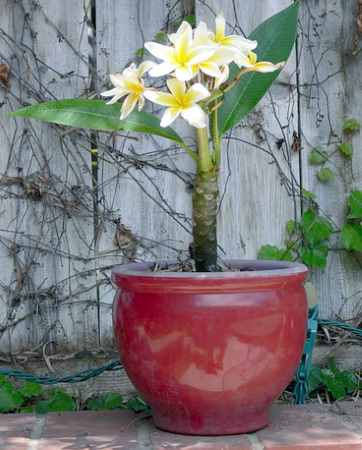
Potted plumeria
Small plumeria trees are ideal for growing in pots. However, if you live in a temperate climate, your only choice to grow a plumeria tree or shrub is in a container, where you will need to store the plumeria plant indoors to overwinter. The good news is that frangipani thrives in pots and can add a touch of the tropics to your patio, deck, or summer container garden.
Potted plumeria trees need to grow in a large container with a coarse, well-draining potting soil mix. An ideal combination is one-part potting soil, one-part perlite, and one-part coarse sand. In place of sand, you can also use crushed granite or calcined clay. It is also vital to ensure that the container has draining holes.
To care for a plumeria tree growing in pots, water the plant deeply until it drains from the bottom. Then wait until the top half of the soil is dry before watering again. You may need to water a potted frangipani at least twice a week in the summer in the growing season. However, you never need to water the plants in winter.
Due to the heavy blooming, a plumeria potted shrub is a heavy feeder and requires regular fertilization. Therefore, a high-phosphorus fertilizer for Hawaiian plumeria plants is ideal. Apply the fertilizer every three to four weeks from spring until fall.
How To Grow Plumeria Plants Indoors
Growing a potted plumeria shrub indoors is possible if they get at least four to six hours of sunlight daily. Water the potting soil as often as the soil dries out. The ideal indoor temperature range for plumeria plants is 64°F to 80°F (18°C – 27°C) and average room humidity.
It is also necessary to fertilize a plumeria growing indoors regularly during the growing season.
Varieties of Plumeria
Let’s look in detail at the two most popular species of plumeria to grow in garden landscapes.
Plumeria pudica

Plumeria pudica Flowers are white with yellow center
Plumeria pudica is an evergreen tropical plant with brilliant white flower clusters and large dark green, ovate leaves. This easy-grow plumeria tree grows between 6 and 15 ft. (1.8 – 4.5 m) tall and has an upwardly spreading crown forming a vase shape. Unfortunately, the striking flowers don’t have a scent.
The Plumeria pudica is a profuse bloomer with trumpet-like flowers consisting of white petals with yellow centers and measuring 3” (7.5 cm) wide.
The attractive tropical flowers contrast with the large, glossy green leaves with an unusual spoon shape or fiddle shape. The shape of the leaves gives the plumeria the common name fiddle-leaf plumeria.

Plumeria pudica leaves have an unusual shape
Due to the stunning white flowers, other names for the Plumeria pudica are bridal bouquet or white frangipani.
Plumeria rubra

Plumeria rubra tree
Plumeria rubra is an exotic deciduous tree with pink or white flowers that have characteristic yellow centers. The frangipani tree has large leaves measuring between 12” and 20” (30 – 50 cm) long, and they grow in clusters on branches. Depending on the growing conditions, the Plumeria rubra grows 5 – 25 ft. (2 – 8 m) tall.
Plumeria rubra flowers are typically pink shades with yellow centers or pure white with yellow centers. The five petals are arranged in a star shape and measure 2” to 3” (5 – 7.5 cm) in diameter.

Plumeria rubra flowers
Plumeria rubra leaves are obovate or elliptic and have a pointed end. In the fall, the glossy green leathery leaves turn red before they drop.
Other common names for Plumeria rubra include red frangipani, temple tree, red paucipan, red-jasmine, or common frangipani.
The fragrant, showy, pleasantly aromatic flowers are one reason why the frangipani is popular in garden landscapes. The plumeria flowers smell like citrus, cinnamon, or sweet rose.
How to Grow Plumeria (Frangipani Tree) in the Garden
Let’s look at some handy tips on how to grow a frangipani tree in your garden.
How to Use Plumeria in Landscapes
The best way to grow a plumeria tree is as a backdrop for smaller shrubs. The long-blooming time of the tree and its tall growth is ideal for adding tropical color to your garden. Also, you can plant a plumeria tree at the corner of the house or use its spreading growth to hide a wall or fence.
Where to Plant Plumeria
Plant a plumeria tree in the sunniest place in your garden. The ground should drain well and be relatively fertile. However, no matter how good the soil is, you will need to fertilize plumeria trees regularly.
In colder climates, you can plant a frangipani tree outside in containers. Then, when the weather drops below 64°F (18°C), you should bring the heat-loving plant indoors to overwinter.
To prevent fungal diseases, it’s a good idea to space plumeria plants at least 4 ft. (1.2 m) apart.
How to Water Plumeria in Landscapes
Plumeria trees need watering as often as the ground dries out. Water the tree by deeply watering the soil around the root base. Then, wait until the soil is dry before watering again. In dry climates, you may have to water a plumeria tree every two weeks. If you get frequent rainfall, then you never have to water the plant.
Plumeria trees don’t like standing in waterlogged ground. Giving the tree too much water or growing in poor draining earth can cause the lush, glossy foliage to turn yellow and fall from the plant.
From late fall until winter, you never need to water the area around a frangipani tree.
How to Encourage Plumeria Branching
Regular spring pruning of your plumeria tree can help to encourage branching. Branching causes fuller, bushier growth on a frangipani tree. Two or three branches grow from each cut. Eventually, you will have a full, bushy tree with attractive foliage and plenty of sweet-smelling waxy flowers.
How to Prune Plumeria Tree
The best time to prune a plumeria tree is in spring before the plant produces new flowers. To promote new branch growth, cut the plumeria branches about 2” (5 cm) above the place where two branches join. If the tree is showing signs of leggy growth, you can prune about 12” (30 cm) higher.
Using sterilized tools, make a cut at a 45° angle, with the angle pointing toward the ground. You will notice a creamy, milky liquid oozing from the cut—so always wear protective gloves when pruning.
After pruning a plumeria tree to restore its shape, you can expect abundant blooms the following season.
Pests and Diseases Affecting Plumeria Growth
Common pests to affect frangipani trees are spider mites, mealybugs, thrips, whitefly, and scale insects. You can look for signs of garden pests under the thick, leathery leaves. The easiest and safest way to get rid of the pests is to use a strong jet of water. This dislodges the pests and often kills them.
If you notice cottony growths on the foliage or branches, this is a sign of mealybugs. You can dip a cotton swab in rubbing alcohol to dab scale insects and mealybugs to kill them on contact.
Black and yellow striped caterpillars are common on plumeria trees. Plumeria trees are host to the Tetrio sphinx moth, and you will usually find the larvae crawling on branches and under leaves. The best way of getting rid of caterpillars is by removing them by hand and dropping them into a bucket of soapy water.

Tetrio sphinx caterpillars
FAQs — Plumeria Care
Plumeria trees are hardy tropical trees that tend to grow without any fuss or special care. Generally, if you protect them from frost, you shouldn’t have any problems. However, a few issues can affect plumeria care.
Why are plumeria flowers dropping?
Waterlogged ground is the most common reason why blooms fall from plumeria trees prematurely. This condition is called plumeria bud drop and it can be remedied by cutting back on watering and ensuring the soil is kept almost dry. Additionally, cold nighttime temperatures can affect flower growth, especially at the end of the season.
Why is my plumeria not flowering?
Three factors can cause a frangipani tree not to bloom. First, not getting at least six hours of sunlight daily can harm blooming. Second, you need to fertilize the blooming trees regularly in the growing season with a high-phosphorus fertilizer. And, lastly, a pest infestation could be stressing the tree.
Also, it’s good to remember that it takes a frangipani tree two to three years to produce its first blooms.
Related articles:
